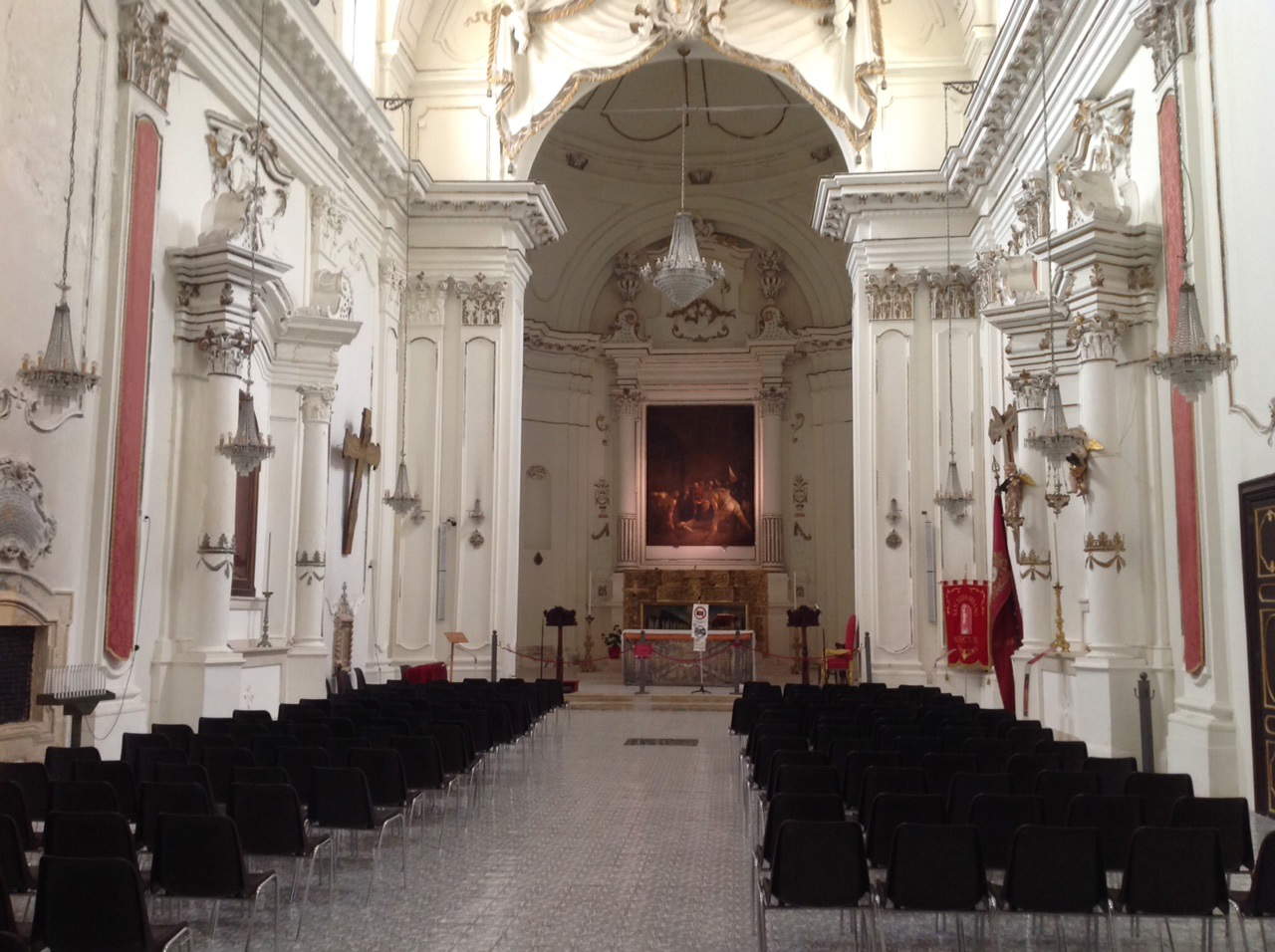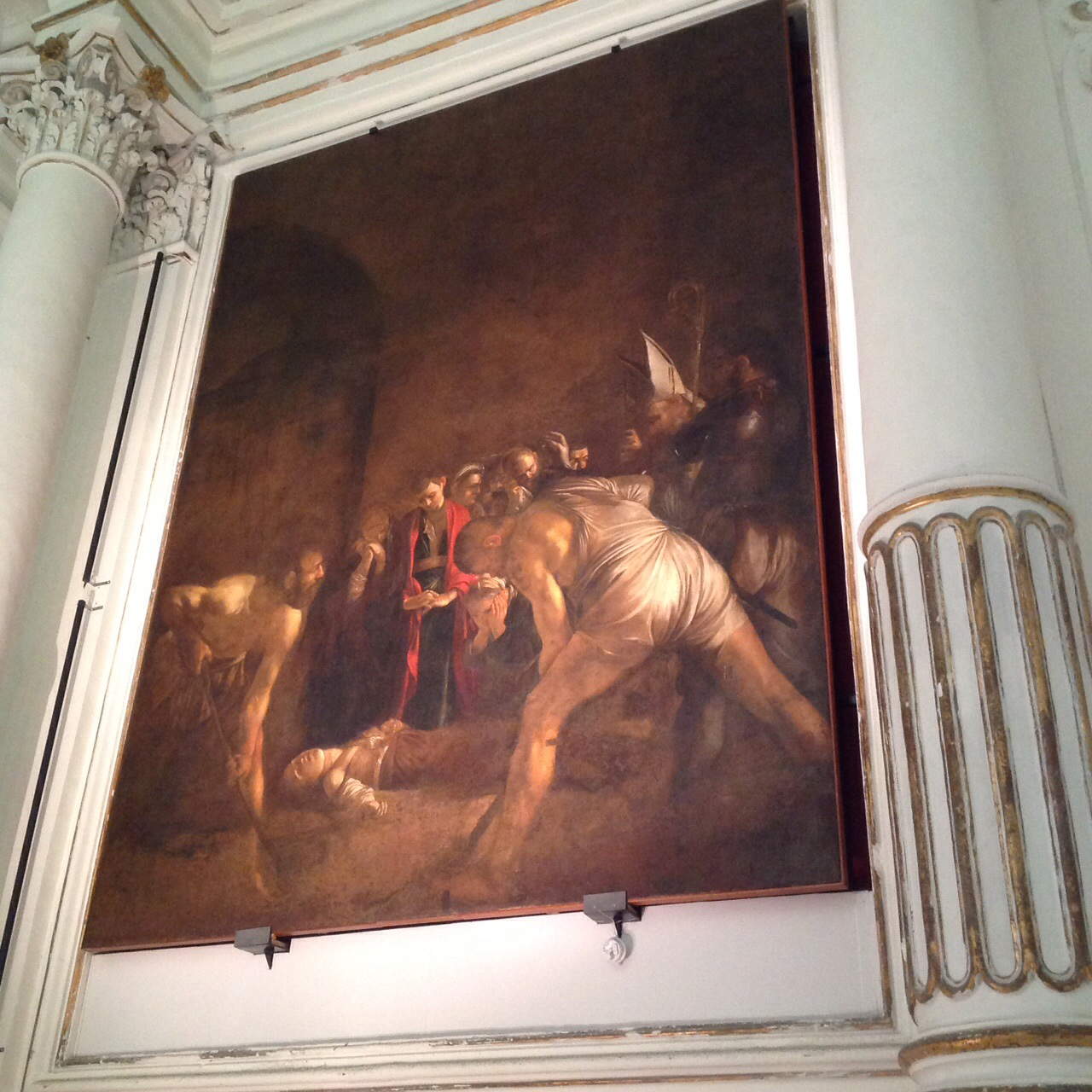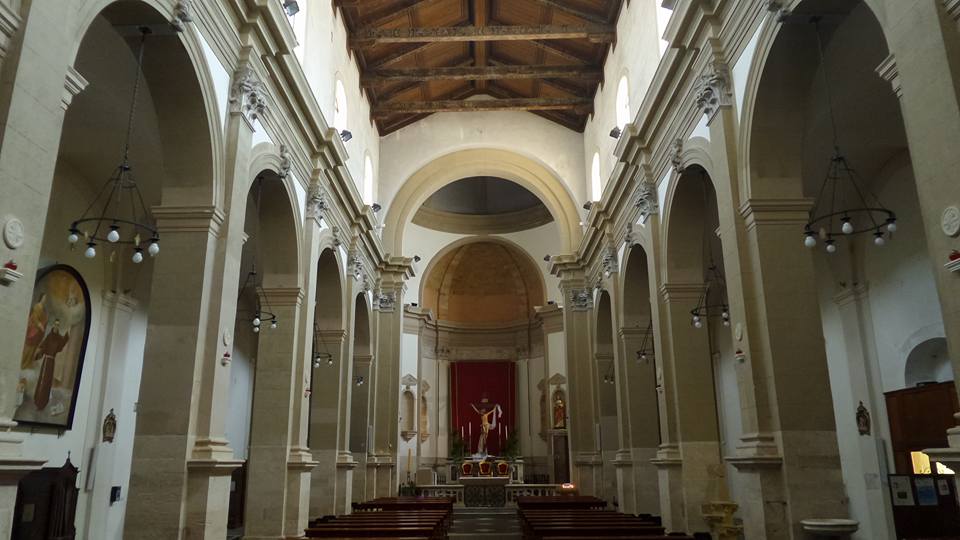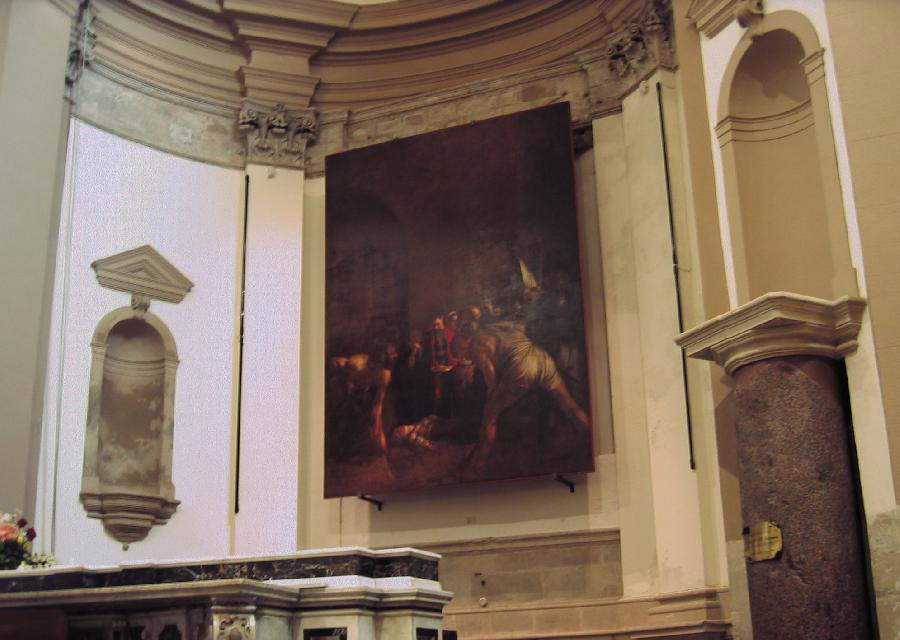“The fate of beauty is danger, and harm, if effective defense and protection mechanisms are not continually in action. Perfect appearance, created to edify the faith of the people or entertain the eyes of the powerful, is exposed to alteration, manipulation, annihilation.” In Il Caravaggio rubato (Sellerio editore, 2012) Luca Scarlini renews the sad scandal with the gray colors of neglect and abandonment, in which in the irredent and Mafia-ridden Palermo of 1969, on the night of October 17-18, the Nativity with Saints Francis and Lawrence from the Oratory of San Lorenzo vanished into thin air.
Fifty years later we are left to wonder whether in Sicily the risk of the loss of a Caravaggio can scandalize “only” if the Mafia is involved. And if it were the institutions that failed those “defense and protection mechanisms,” would it be, perhaps, less serious?
 |
| Caravaggio, Burial of Saint Lucy (1608; oil on canvas, 408 x 300 cm; Syracuse, Santa Lucia alla Badia) |
Fifty years later, another Caravaggio in the land of Sicily falls victim to an unjustifiable distraction. While all eyes in Syracuse are on the “yellow,” between contradicting aldermen, duplicate posters with ad hoc variant, and journalistic articles adjusted in haste on the web, that accompanies the opening of the exhibition (on April 13) dedicated precisely to another painting by the Master, the Crucifixion of St. Andrew, from the Spier collection in London, we take the luxury of losing sight of the Caravaggio masterpiece that Syracuse permanently owns: The Burial of St. Lucy. A work of the last period, “of a novelty equal only to the simplicity with which it is conceived,” said Cesare Brandi, in which Merisi invents the emotional weight of emptiness, a new way, that is., of conceiving vast spatialities in which the absence of matter, by contrast, greatly burdens the sensory sphere of the relative, has for eight years been consigned to an unacceptable condition of both conservation and exhibition. It was in 2011 when it was, in fact, moved, then it was said temporarily, to the church of Santa Lucia alla Badia where it stands today, in Piazza Duomo, from the church of Santa Lucia extra moenia, in the Borgata district, which did not offer adequate thermo-hygrometric parameters. Here, on the high altar for which it was made in 1608 by the painter fleeing from Malta, it had been brought back five years earlier, seizing the opportunity of the refurbishment of the Regional Gallery of Palazzo Bellomo, which had kept the painting, on loan for use, since 1983. Only a few years later, however, would it be learned that the church to which it had been transferred, in Piazza Duomo, also has temperature and relative humidity values that exceed the optimal limit, with percentages as high as 100 percent, according to the alarming data revealed by the microclimatic monitoring carried out, over a calendar year (2014-2015), by the Regional Center for Design and Restoration (CRPR) in Palermo, in both churches. And while it is since then that these data have been in the possession of the bodies in charge of protection, it is now already two years since they were also made public at the conference held on May 18, 2017 at Bellomo itself, precisely in response to the questions that the writer posed at the time about the painting’s state of conservation, as well as its questionable choice of display.
How much longer, in fact, can one remain indifferent to the scandalous circumstance whereby the work is leaning against the legitimate altarpiece, the “Martyrdom of St. Lucy.” an incomprehensible “palimpsest” in itself already deplorable, for the total disregard of the basic notions about the valorization and fruition of works of art, even if it were a lesser-known painter and not the polidoresque Deodato Guinaccia, and which becomes even more serious for a whole series of criticalities that it could trigger under the conservation profile. They had been well pointed out in that same 2017 conference by restorer Franco Fazzio, who had taken part in the diagnostic investigations conducted in 2006 by CRPR, in synergy with the Physics Department of the University of Palermo. The restorer had also been able to detect a suspicious stain on the back of the canvas: “Caravaggio’s painting,” Fazzio had explained in Syracuse, "was restored at the former Icr in Rome between the years 1972-79 and re-tinted with the technique defined as ’classical’ in that it was based on the use of traditional materials, almost exclusively organic in nature, such as animal gelatines and adhesives based on vegetable flours. These, under ideal microclimatic conditions provide a perfect breeding ground for the development of microorganisms, particularly by fungal spores. The suboptimal values detected in the church offer serious hints for an attack by biodeteriogenic agents that would have as a breeding ground the work of Caravaggio and from this the easy propagation to the painting immediately behind, victim of a greenhouse effect microclimate".
This is probably a unique case in the whole of Italy, where not one, but two works of art could be damaged at once.
 |
| Caravaggio’s work in the church of the Badia |
 |
| Caravaggio’s work in the church of the Badia |
 |
| The church of Santa Lucia extra Moenia in Syracuse |
 |
| Caravaggio’s work at the Borgata |
The parties called upon by the Caravaggio issue: Superintendency, Fec, Municipality, CRPR, ISCR, Regional BBCC Council
To be called into question, mind you, is not only the Superintendence. Like, and perhaps even more than Caravaggio’s other works in the church of San Luigi dei Francesi, in Santa Maria del Popolo, in Sant’Agostino in Rome or in the Cathedral of San Giovanni alla Valletta, the Burial of St. Lucy is intimately linked to the place for which it was painted, whose atmosphere, light, history and devotional dimension it shares. The experience of returning it, between 2006 and 2011, to the original church has, however, proved unsuccessful, not only, as it was said at the time, because of the prohibitive thermo-hygrometric conditions of the environment, but also because of the lack of theconcerted action that it would be desirable for it now to be reached between the Region (Superintendence), Fec, owner of the painting (and of both churches), and the Municipality, for the redevelopment of the Borgata neighborhood and the provision of the necessary services, which to date are nonexistent. Indispensable, then, to involve, for technical aspects, the CRPR and the Superior Institute for Conservation and Restoration in Rome. The Regional Council of Cultural Heritage, the counterpart (with substantial differences, however) of the MiBAC’s Higher Council, should also be called upon to express an opinion, were it not for the fact that this body re-instated byformer governor Rosario Crocetta in 2017, after almost two lustrious absences, then parked by President Nello Musumeci, except for remembering it a few months ago to try to unravel the chaotic institution of Sicilian archaeological parks, not only has a questionable composition, but, in the case of our interest, very little it could say, given that there is no art historian and/or restorer within it.
Despite CRPR’s investigation of the painting and the two churches, and a dedicated conference, the Caravaggio issue is still at year zero
We asked Syracuse Superintendent Donatella Aprile, who inherited the thorny matter (she has been in office since last September) what solutions she intends to put in place. The orientation is to give substance to the intention of returning the canvas to the church where it originally belonged, dusting off the old project of a microclimatized display case to remedy the inadequacy of the environment. Now dated, however. Prepared by CRPR, it dates back 13 years. “In place we have interlocutions with the Fec, which has funds available,” the superintendent also told us. But it is unclear what would need to be funded without a project. “We also need to ascertain the current conservation condition of the painting,” she pointed out. There is, in general, the impression that we are back to square one: the superintendent pledges to retrieve the outcome of the investigations on the painting and those on the two churches, and “to acquire the opinion of the CRPR and ISCR technicians.” It also remains to reconsider a more appropriate remounting for a masterpiece that would also require the establishment of a scientific committee. While bringing all the above actors together would require convening an inter-institutional operational table. The April seems, however, convinced that the permanence of the work in the current church of Santa Lucia alla Badia cannot be postponed any longer and is also thinking of a temporary solution. Hoping that such will not remain for another eight years!
Does the painting need a new conservation intervention?
While waiting, then, to give concreteness to the project of returning the canvas to its original church of belonging, one solution could be a new musealization of the painting at Bellomo itself. The suitable environment would be there. It is the room on the ground floor, currently used for conferences, already air-conditioned and, of course, equipped with an anti-theft system, which the painting could conveniently access from the courtyard. The solution, already endowed with validity in terms of both conservation and exhibition, could be further validated by the intention to turn it into an opportunity to review the historic restoration carried out by the then Icr, since which a good 40 years have passed. The Superintendent tells us that she wants to evaluate the issue we raised. The non-destructive investigations carried out on the painting by the Crpr of Palermo in 2006 had, in fact, also made it possible to detect, for the first time, an error in a restoration (directed by Alma Maria Mignosi Tantillo and Michele Cordaro, conducted by Laura and Paolo Mora) that also made case law. “During the 2006 investigation campaign, ultraviolet fluorescence,” Fazzio had also explained in Syracuse, “allowed the reading of the layers of the various layers of varnish applied on the pictorial surface of the Caravaggio painting. The surprising result highlighted the remarkable inhomogeneity of this protective film made of large imbalances, discontinuities and oxidation at various intensities, with disturbance, in the visible, of the proper reading of the entire pictorial surface.” But that is not all. “Another significant aspect is that the application of the varnishes took place with the painting not placed in a horizontal plane, as practice requires, but arranged and positioned sideways and/or cutting, moreover horizontally with respect to the verticality of the scene. All this, as an operation, would be little questionable if one did not notice, in several parts of the surface, the clumsy drafting with abundant brush strokes, such as to have produced conspicuous percolations.”
And again. If in 2006 the diagnostic state offered “a clinical picture not despairing,” "a fair state of preservation,“ no detachment of the paint film or loosening of the tension of the canvas, in short, a condition of conservative stability of the painting, and if still Maurizio Marini in the catalog of the Caravaggio exhibition in Trapani between 2007 and 2008 spoke of ”acceptable conservation conditions,“ it is perhaps legitimate to wonder today, in light of all the conservation criticalities exposed above, at what point is that suspicious stain on the back of the canvas, resulting, in Fazzio’s opinion, from the ”probable alteration of the adhesive paste glue used to adhere the new canvas (which dates back to the 1979 restoration at the former Icr, Ed.) to the original one.“ The restorer has no doubts: ”a new biological investigation would be needed."
The room that would house the Caravaggio could, therefore, be transformed into a laboratory-window open to the public, with the involvement of the ISCR in Rome and the CRPR in Palermo, which would further strengthen the conservation profiles of the operation.
Considering, on the other hand, the final destination that will bring the painting back to the church at the Borgata, the writer has already proposed that public funding channels (Fec funds, sums available to the Assessorato BB.CC.IS., sponsorship) be flanked by crowdfunding (the first in Sicily). Visitors to the Bellomo, but also the citizens themselves, would be invited to purchase “An Action for Caravaggio,” like those on which one invests in the stock market. Even so, investing in heritage to sustain it means accessing a share-part of it, in the belief that the reappropriation of collective goods also passes through these forms of social protagonism. An act of appeal to civil society to extend a hand to Saint Lucia, to put back on its feet a masterpiece prostrate more than that young lifeless body on the bare ground, halfway between a latomy and a catacomb.
Warning: the translation into English of the original Italian article was created using automatic tools. We undertake to review all articles, but we do not guarantee the total absence of inaccuracies in the translation due to the program. You can find the original by clicking on the ITA button. If you find any mistake,please contact us.